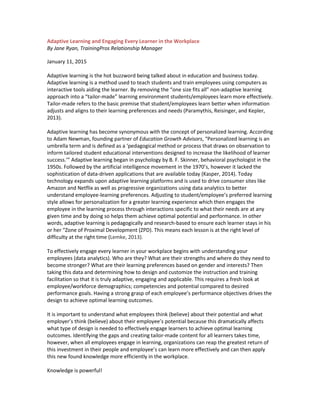
TP Learning Insights Blog Adaptive Learning and Engaging Every Learner in the Workplace
- 1. Adaptive Learning and Engaging Every Learner in the Workplace By Jane Ryan, TrainingPros Relationship Manager January 11, 2015 Adaptive learning is the hot buzzword being talked about in education and business today. Adaptive learning is a method used to teach students and train employees using computers as interactive tools aiding the learner. By removing the “one size fits all” non-adaptive learning approach into a “tailor-made” learning environment students/employees learn more effectively. Tailor-made refers to the basic premise that student/employees learn better when information adjusts and aligns to their learning preferences and needs (Paramythis, Reisinger, and Kepler, 2013). Adaptive learning has become synonymous with the concept of personalized learning. According to Adam Newman, founding partner of Education Growth Advisors, “Personalized learning is an umbrella term and is defined as a ‘pedagogical method or process that draws on observation to inform tailored student educational interventions designed to increase the likelihood of learner success.’” Adaptive learning began in psychology by B. F. Skinner, behavioral psychologist in the 1950s. Followed by the artificial intelligence movement in the 1970’s, however it lacked the sophistication of data-driven applications that are available today (Kasper, 2014). Today technology expands upon adaptive learning platforms and is used to drive consumer sites like Amazon and Netflix as well as progressive organizations using data analytics to better understand employee-learning preferences. Adjusting to student/employee’s preferred learning style allows for personalization for a greater learning experience which then engages the employee in the learning process through interactions specific to what their needs are at any given time and by doing so helps them achieve optimal potential and performance. In other words, adaptive learning is pedagogically and research-based to ensure each learner stays in his or her “Zone of Proximal Development (ZPD). This means each lesson is at the right level of difficulty at the right time (Lemke, 2013). To effectively engage every learner in your workplace begins with understanding your employees (data analytics). Who are they? What are their strengths and where do they need to become stronger? What are their learning preferences based on gender and interests? Then taking this data and determining how to design and customize the instruction and training facilitation so that it is truly adaptive, engaging and applicable. This requires a fresh look at employee/workforce demographics; competencies and potential compared to desired performance goals. Having a strong grasp of each employee’s performance objectives drives the design to achieve optimal learning outcomes. It is important to understand what employees think (believe) about their potential and what employer’s think (believe) about their employee’s potential because this dramatically affects what type of design is needed to effectively engage learners to achieve optimal learning outcomes. Identifying the gaps and creating tailor-made content for all learners takes time, however, when all employees engage in learning, organizations can reap the greatest return of this investment in their people and employee’s can learn more effectively and can then apply this new found knowledge more efficiently in the workplace. Knowledge is powerful!
- 3. Sources: Lemke, C. (2013). Intelligent adaptive learning: An essential element of 21st century teaching and learning. The Metiri Group. Retrieved from http://www.dreambox.com/adaptive- learning#sthash.jstvaY9J.dpuf Paramythis, A., Loidl-Reisinger, S., & Kepler, J. (2004). "Adaptive Learning Environments and e- Learning Standards". Retrieved from http://www.ejel.org Spiro, K. (2014). eLearning trends leading to the end of the learning management system. Retrieved from http://elearningindustry.com/5-elearning-trends-leading-to-the-end-of-the- learning-management-system
